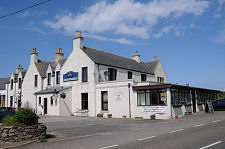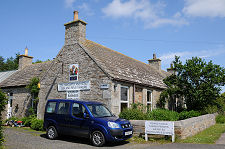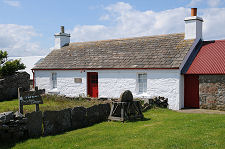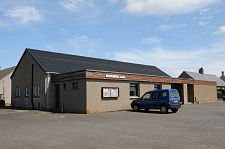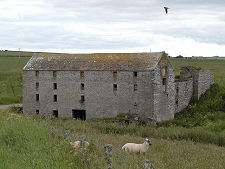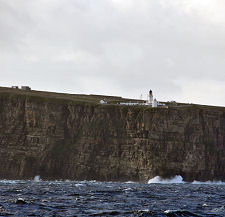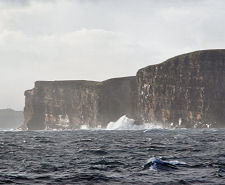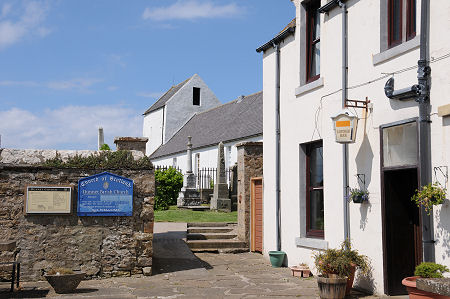 Northern Sands Hotel and Dunnet Church |
The village of Dunnet stands close to the north-east corner of Dunnet Bay. To the south is nearly two miles of beautiful sandy beach backed by magnificent dunes, forming the eastern end of the bay. The Seadrift Visitor Centre is an excellent way of finding out more about the coastal environment of Dunnet Bay and the wildlife who call it home.
To the north of Dunnet the land gently rises to form Dunnet Head, the most northerly point in mainland Britain whose cliffs fall 300ft sheer into the Pentland Firth. At its maximum extent the headland is some 3.5 miles from north to south and 2.5 miles from east to west. On a clear day the northern end commands some of the most extensive views you are likely to find anywhere in northern Scotland. These include the Orkney Islands to the north, and the length of the north coast of Scotland from Duncansby Head, 13 miles to the east, to Cape Wrath, just under 60 miles to the west.
The end of the road at Dunnet Head is about 4.5 miles from Dunnet itself, and is well worth the trip for anyone interested in visiting the geographical extremes of the island we live on, and especially if the visibility is good. The northern end is home to a number of disused lookouts and other structures built during the World War II to help defend the naval base at Scapa Flow on Orkney. Also sitting above the cliffs is the lighthouse built here by the Stevenson family in 1832. The ferocity of the Pentland Firth is such that windows at the lighthouse have been broken by stones thrown up by the sea far below.
Dunnet itself runs along the line of the A836 coast road, but then extends north-west in a highly scattered pattern of houses and cottages interspersed with meadows full of flowers. The habitation tends to peter out as the land begins to climb, and overlooking the whole village, and much else besides, is The House of the Northern Gate, a large house built in 1903 which must enjoy some of the best views in Scotland, and one of the most exposed locations you will find anywhere. In 1952 it was owned by Commander and Lady Vyner and the very recently widowed Queen Elizabeth The Queen Mother was staying here when she first saw the Castle of Mey, just along the coast, which she went on to purchase. In contrast it is said that in the 1970s the rock group Led Zeppelin was considering buying the house for use as a recording studio.
At a rather lower level is Mary Ann's Cottage. This is a traditional croft comprising a collection of single storey buildings. It was worked for many years by Mary Ann Calder and her husband. Mary Ann lived here until she was 93 in 1990. It is open to the public in the summer months and maintained as it was when she left, a farming croft in continuous occupation since it was built in the first half of the 1800s. Below the cottage on the shore is the attractive Dwarwick Harbour, whose pier was built in the 1890s and rebuilt in the 1970s. It is home to a plaque remembering its use by the Royal Family coming ashore from the Royal Yacht Britannia en route to the Castle of Mey on 12 August 1955.
Most local amenities in Dunnet are located alongside the main road through the village. Here you find the Britannia Hall, which serves as the village hall. On the opposite side of the road is the attractive Northern Sands Hotel. Reached, unusually, via a gate by the front corner of the hotel, is Dunnet Church. Parts of the church date back to 1270, though much of what you see today dates back to the period after the Reformation in 1560, with further changes and additions in the 1700s and 1800s. Dunnet Church is notable in having as its minister from 1601 to 1614 the mapmaker Timothy Pont. He is remembered by a mural memorial, but sadly when we called the church was not open to visitors.
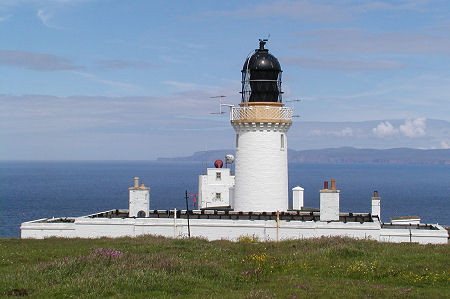 Dunnet Head Lighthouse with Orkney in the Background |
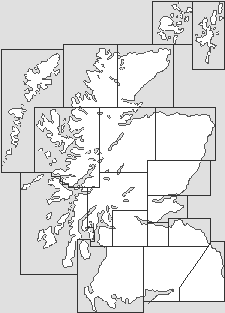
|
|
|
Visitor InformationView Location on Map |
Dunnet Head In Fiction
|
 Dunnet Church |
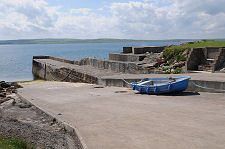 Dwarwick Harbour |
 The House of the Northern Gate |
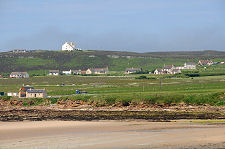 Dunnet Seen from the South |
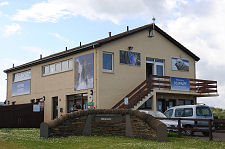 Seadrift Visitor Centre |
 Thicker Than Water by Ken Lussey (15 September 2024).
Thicker Than Water by Ken Lussey (15 September 2024).